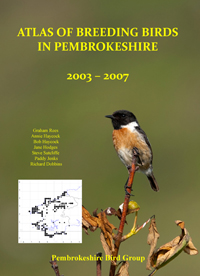Breeding summer visitor and passage migrant. Not recorded from December to March
Reed Warblers were not recorded by Mathew (1894), while Lockley et al (1949) noted just four records, the first being at the Smalls lighthouse on 17 October 1908.
They were first proved to be breeding at Nevern in 1975, although they had been present in suitable reedbed habitat at Pentood and Slebech from 1974. However, Lloyd records in his diary that H.R. Chubb claimed to have seen a pair and their nest at Goodwick Moor in 1934 or 1935, and Lloyd himself strongly suspected that they had bred at Tenby Marsh in 1931. They have continued to colonise Pembrokeshire since 1975, and may now have occupied most of the available suitable habitat. The total breeding population is currently about 60 pairs (see map).
Reed Warblers are occasionally detected on both spring and autumn passage, from 26 April to 17 June and from 22 August to 25 October. Singles were recorded at Skomer on 7 July 1986, at Strumble Head on 1 November 1987 and at the Smalls on 2 November 1982.

Fieldwork 1984-88 (based on 478 tetrads)
Red = breeding confirmed = 8
Orange = breeding probable = 10
Yellow = breeding possible = 3
Total tetrads in which registered = 21 (4.4%)
Donovan J.W. & Rees G.H (1994), Birds of Pembrokeshire
 Friday, August 9, 2013 at 7:48AM
Friday, August 9, 2013 at 7:48AM  1949 BoP in
1949 BoP in  Reed Warbler
Reed Warbler 



